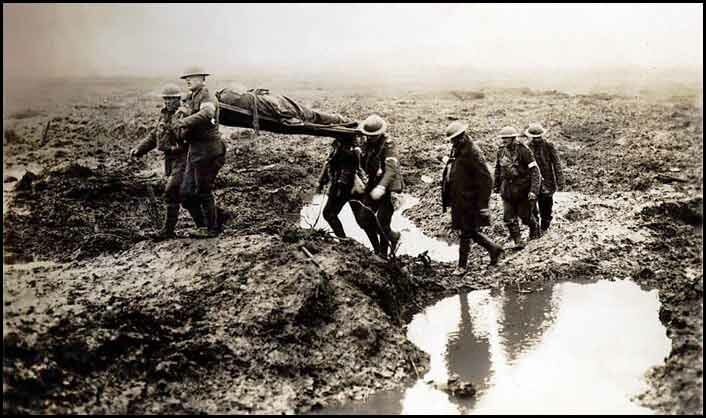 |
| Canadian stretcher bearers |
That's what it looked like just outside the town of Ypres, in western Belgium, in the spring of 1915. The Allies had pushed the Germans out of the town after the first few months of the First World War. And to get it back, the Germans were ready to use a new weapon that they only tried once before, unsuccessfully, against the Russians on the Eastern Front. So in late April, they hauled thousands of heavy cylinders toward the Allied lines and opened them, freeing the chlorine gas within. The yellow-gray clouds swept down upon ten thousand French troops, suffocating them, burning away at their eyes and lungs, driving them out of their trenches and into enemy fire. Coughing and frothing at the mouth, dying, panicked, the French fell back in disarray, leaving a gaping hole in the middle of the Allied lines.
Between the crosses, row on row,
The larks, still bravely singing, fly
Scarce heard amid the guns below.
We are the Dead. Short days ago
We lived, felt dawn, saw sunset glow,
Loved and were loved, and now we lie,
In Flanders fields.
Take up our quarrel with the foe:
To you from failing hands we throw
The torch; be yours to hold it high.
If ye break faith with us who die
We shall not sleep, though poppies grow
In Flanders fields.
McCrae survived the battle, but not the war. He died of pneumonia in France. By then his poem was already one of the most famous in the world. And a few months later, just two days before the war finally ended, an American teacher read a copy of it in Ladies Home Journal. She was so touched that she immediately pledged to wear a poppy for the rest of her life—and set to work convincing community groups and veterans' organizations around the world to do the same, every year, and remember.
"[O]ne saw all the sights of war: wounded men limping or carried, ambulances, trains of supply, troops, army mules, and tragedies. I saw one bicycle orderly: a shell exploded and he seemed to pedal on for eight or ten revolutions and then collapsed in a heap -- dead. Straggling soldiers would be killed or wounded, horses also, until it got to be a nightmare. [...] Three farms in succession burned on our front -- colour in the otherwise dark. The flashes of shells over the front and rear in all directions. The city still burning and the procession still going on. I dressed a number of French wounded; one Turco prayed to Allah and Mohammed all the time I was dressing his wound. On the front field one can see the dead lying here and there, and in places where an assault has been they lie very thick on the front slopes of the German trenches."
The dates and exact locations can be a bit sketchy, but there's a seemingly endless supply of breathtaking photos from Ypres during WWI. You can see what John McCrae looked like here, and what the cemetery, Essex Farm, looked like just after the war here. There's a (very small, I'm afraid) photo of the German chlorine gas canisters here. Here's a photo of German troops advancing through the clouds of gas, with more troops doing the same here, and Frenchmen who've been killed by it here. There's an explosion from a German barrage here and an example of the kind of damage that could be done here. You'll find a nice collection of photos of Ypres here, including some of the later battle, Passchendaele. There are lots of photos of that, the Third Battle of Ypres; like here and here and here and here and here. Amazingly, some of them are even in colour: Canadians here and here, and some of the most terrifying Germans you've ever seen here. Even just a quick Google image search will turn up dozens more; I could go on linking for hours.








No comments:
Post a Comment
Note: Only a member of this blog may post a comment.